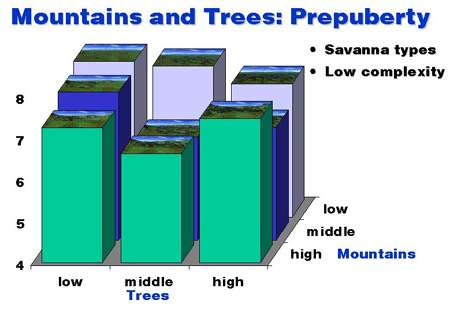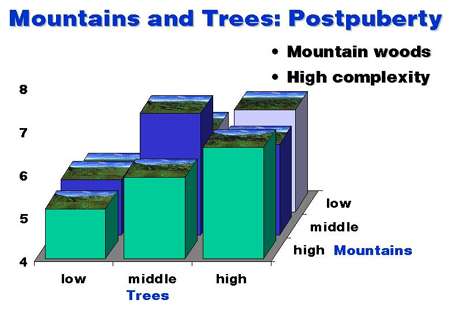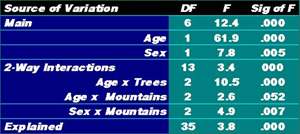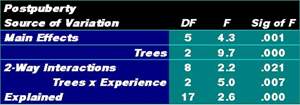Evolutionary
Aesthetics:
Visual
Complexity and the Development of Human Landscape Preferences
Erich Synek and Karl Grammer
"Aesthetic
response is defined as preference or like-dislike affect in association
with pleasurable feeling and neurophysiological activity elicited
by visual encounter with an environment" (ULRICH, 1986)
Savanna-Hypothesis
Humans
lived the most time of their evolutionary past in the savannas of
tropical Afrika (the nowadays presumed site of human origins).
Therefore our aesthetic answers to landscapes should be influenced
by environmental key-features we also find in the savanna.
The less experience an individual has with the environment it is actually
living in, the more it should prefer savanna-like landscapes.
"Research on landscape preferences strongly indicates that savanna-like
environments are consistently better liked than other environments
(see reviews in Balling and Falk, 1982; Ulrich, 1983, 1986).
In the only direct test of preferences for the different biomes, BALLING
& FALK (1982) hypothesized that humans have an innate preference
for savanna-like environments that arises from their long evolutionary
history on the savannas of East Africa.
They argued that an "innate predisposition" for the savanna should
be more likely to be revealed in children than in adults because adults
are likely to have had experience living in biomes other than savannas.
Their study included six age groups (8, 11, 15, 18, 35, and 70 or
over).
Interestingly, the desert was the last liked environment for all age
groups; and two slides of the savanna during the dry season also received
lower ratings than the greener savanna settings.Because none of the
respondents in the Balling and Falk study had ever been in tropical
savannas, the authors postulate a developmental pattern, with innately
programmed responses that are later modified by experience in particular
settings ( in this case, the deciduous woods of the eastern U.S.).
"
Visual
Complexity
An alternativce
explanation, to the theroetical approaches above stems from a relationship
between visual complexity of landscapes and perceived scenic beauty.
Several models of scenic quality are based on an assumed correlation
between visual complexity and increasing aesthetic quality The development
of these models was influenced by similar relationships in ecology,
especially the diversity=stability relationship described by terrestrial
ecologists, which proposed that increasing ecological diversity is
correlated with increasing stability, and hence with environmental
quality. Thus we could assume that there is a relationship between
visual complexity and perceived scenic beauty.
Method
Stimulus
generation
All images
were designed on a Power-Mac 9500 using the program KPT Bryce®
1.01 .
This software allows to make a snapshot from a virtual landscape.
All pictures are available in a larger version (try clicking on a
small one).
|
|
From
left to right: increase of tree density
From top to bottom: increase of height
differences |
Rating
study
104
(52 male) children age 10.8 84 (42 male) children age 15.2 All
children lived in Vienna and had experience
with all presented landscape types. The rating was :Would you
like to live there (1-5) ? and Would you like to spent your
holidays there (1-5) ? Experience with a landscape was determined
by a 50% rule. If the child had spent more then 50% of its lifetime
in the mountains (with many forests) experience was coded as
yes.
Complexity
With digital image analysis the fractal dimension of each pictures
was determined. In a second rating study (n=18) students rated
the pictures complexity. Computer generated complexity correlates
with perceived complexity (.81).
|
Results
Children
before puberty show the highest preferences for low trees and low
mountains landscapes. Interestingly the basic landscapes these children
have experienced around Vienna are low tree, low mountains and high
tree, high mountains landscapes. Before puberty children prefer low
complexity, savanna type landscapes.(see below)

This
picture is reversed after puberty. Children after puberty prefer mountains
and trees (see below) and the preferences shift towards high complexity
mountain types of landscapes.

When
we apply a mountains (3) x trees (3) x age (2) x sex (2) anvova we
find effects for age and sex. Younger
children rate higher and males rate higher. Two way are between age
and trees age and mountains and sex and mountains. Younger children
prefer less trees and mountains. Females prefer mountains.

The effects
of experience with mountain type landscapes are also significant.
With experience prepuberty higher have general higher ratings and
after puberty trees are rated highest. Experience (50% of living time)
thus seems to make more sensitive for landscapes and experience with
trees and mountains leads to a preferences for these landscapes after
puberty (see below)


Discussion
Complexity,
savanna theory and imprinting
The results
show a partial replication of the Balling and Falk hypotheses. Prepuberty
children prefer savanna type landscapes of low complexity. Prepuberty
experience also changes landscape perception. And we we find a higher
sensitivity for landscapes. The perception of optimal landscape changes�
with puberty according to previous experience. We hypothesize that
there is either a learning process where the optimal habitat is connected
to landscapes. This could be also an effect of ecological richness
and variety of more complex landscapes. Annother point could be that
chtere is an imprinting like process. A habitat where an individual
was able to reach puberty could also be a good habitat. In adition
it could be of advantage that the habitat of ones parents should be
preferred, because it allowed them to raise offspring. Nevertheless
there is a problem with stimulus processing which could change during
puberty and lead to a preference for more complex stimuli after puberty.
This question will be addressed by future cross cultural research.
Literature
Balling,
J.D and Falk, J.H. (1982): "Development
of visual preference for natural environments" Environment and
Behavior, 14(1), 5-28
Jerome
H. Barkow; Leda Cosmides; John Tooby: "The Adapted Mind",
Evolutionary Psychology and the Generation of Culture
Gordon
H. Orians; Judith H. Heerwagen: "Evolved Responses to Landscapes",
from "The Adapted Mind", 555-579
Stephen
Kaplan: "Environmental Preference in a Knowledge-Seeking, Knowledge-Using
Organism", from "The Adapted Mind", 581-598
Kaplan,
S. (1987): "Aethetics, affect, and cognition: Environmental
preference from an evolutionary perspective", Environment and
Behavior, 19(1), 3-32.
Rachel
Kaplan & Stephen Kaplan (1989): "The experience of nature:
a psychological perspective"
Matthews
M. H. (1992): "Theoretical perspectives on children's environmental
capability and competence", from "Making sense of places"
Foley
R.A.: "The influence of seasonality on hominid evolution",
from "Seasonality and Human Ecology" (Society for the Study
of Human Biology: Symposion 35, Edited by S.J Ulijaszek and S.S. Strickland)
Leda
Cosmides and John Tooby (1987): "From Evolution to Behavior:
Evolutionary Psychology as the Missing Link", from "The latest
on the best" (Edited by Dupr)
Irenäus
Eibl-Eibesfeldt (1995): "Der Mensch und sein Lebensraum-ökologische
Betrachtungen", aus "Die Biologie des menschlichen Verhaltens"
Orians,
G.H. (1980): "Habitat selection: General theory and applications
to human behavior", from The Evolution of Human Social Behavior
(Edited by Lockard S.J)
Linda
Mealey and Peter Theis: "The Relationship Between Mood and
Preferences Among Natural Landscapes: An Evolutionary Perspective",
from Ethology and Sociobiology, Vol. 16, Nr. 3, May 1995
Orland
Brian, Weidemann Edward, Larsen Larissa, Radja Paul (April 1997):
"Exploring the Relationship between Visual Complexity and Perceived
Beauty", from URL http://imlab9.landarch.uiuc.edu/projects/compleximages/complexity.html
Heerwagen,
J. and Orians, G. (1986): "Adaptations to windowlessness: A
study of the use of visual decor in windowed and windowless offices",
Environment and Behavior, 18(5),623-638.
Herzog,
T. (1988): "Danger, mystery, and environmental preference",
Environment and Behavior, 20(3), 320-344.
Orians,
G. (1986): "An ecological and evolutionary approach to landscape
aesthetics" Landscape meaning and values (Edited by E.C.Penning-Rowsell
& D.Lowenthal), pp.3-25
Ulrich,
R. (1986): "Human response to vegetation and landscapes",
Landscape and Urban planning, 13, 29-44
Ulrich,
R. (1983): "Aesthetic and affective response to natural environment",
Behavior and the natural environment (Edited by I.Altmann & J.F.Wohlwill),
pp.85-125
